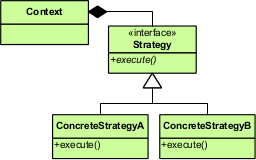According to the strategy pattern, the behaviors of a class should not be inherited. Instead, they should be encapsulated using interfaces. This is compatible with the open–closed principle (OCP), which proposes that classes should be open for extension but closed for modification.
As an example, consider a car class. Two possible functionalities for car are brake and accelerate. Since accelerate and brake behaviors change frequently between models, a common approach is to implement these behaviors in subclasses. This approach has significant drawbacks; accelerate and brake behaviors must be declared in each new car model. The work of managing these behaviors increases greatly as the number of models increases, and requires code to be duplicated across models. Additionally, it is not easy to determine the exact nature of the behavior for each model without investigating the code in each.
Brake*brakeBehavior=newBrake();
packageorg.wikipedia.examples;/* Encapsulated family of Algorithms * Interface and its implementations */interfaceIBrakeBehavior{publicvoidbrake();}classBrakeWithABSimplementsIBrakeBehavior{publicvoidbrake(){System.out.println("Brake with ABS applied");}}classBrakeimplementsIBrakeBehavior{publicvoidbrake(){System.out.println("Simple Brake applied");}}// Client that can use the algorithms above interchangeablyabstractclassCar{privateIBrakeBehaviorbrakeBehavior;publicCar(IBrakeBehaviorbrakeBehavior){this.brakeBehavior=brakeBehavior;}publicvoidapplyBrake(){brakeBehavior.brake();}publicvoidsetBrakeBehavior(IBrakeBehaviorbrakeType){this.brakeBehavior=brakeType;}}// Client 1 uses one algorithm (Brake) in the constructorclassSedanextendsCar{publicSedan(){super(newBrake());}}// Client 2 uses another algorithm (BrakeWithABS) in the constructorclassSUVextendsCar{publicSUV(){super(newBrakeWithABS());}}// Using the Car examplepublicclassCarExample{publicstaticvoidmain(String[]arguments){CarsedanCar=newSedan();sedanCar.applyBrake();// This will invoke class "Brake"CarsuvCar=newSUV();suvCar.applyBrake();// This will invoke class "BrakeWithABS"// set brake behavior dynamicallysuvCar.setBrakeBehavior(newBrake());suvCar.applyBrake();// This will invoke class "Brake"}}


